matlab 2012 vs2010混合编程
电脑配置:
操作系统:window 8.1
Matlab 2012a安装路径:D:\Program Files\MATLAB\R2012a
VS2010 :
OpenCV 2.4.3:D:\Program Files\opencv
补充说明:
在配置前,先检查一下系统变量:
1.若缺少系统变量(该路径必须添加!!!):
D:\Program Files\MATLAB\R2012a\runtime\win64
导致结果:程序无法正常启动0x000007b。请单击“确定”关闭应用程序
注意变量配置后记得重启才会生效,而且添加路径要在英文符号下加入” ; ”,末尾不需要加分号!!!!
2.其他变量:可加可不加,经验证不会影响结果!!!
(1)用户变量:
D:\Program Files\MATLAB\R2012a\bin\win64
D:\Program Files\MATLAB\R2012a\runtime\win64
(2)系统变量:
D:\Program Files\MATLAB\R2012a\bin\win64
本文转自博客:http://www.cnblogs.com/newpanderking/articles/4057977.html
1、背景
众所周知,matlab在处理矩阵、数学计算、计算机仿真、图像处理等方面有着 c c++无可比拟的优势,但是做成系统供使用时,又显得过于粗糙,为了使用起来高大上,计算起来有简单,方便。无疑,c++ 与matlab混合编程将会使非常靠谱的选择。
这里暂且不论所谓的matlab效率低,c/c++效率高的问题,自我感觉,以我目前编码的功底,所编写的代码的效率远远不及matlab提供的代码的效率。除非你是大牛,或者你是人云亦云,所以能用matlab混合c++编码还是很不错的选择,话不多说,我们开始讨论正题。
2、我使用的版本是matlab2012与vs2010混合编程的。
软件的下载这里就不多说了,我相信看这篇教程的你,这两个软件已经安装的妥妥当当的了。
这里我选用网上常用来做例子的matlab代码做测试,spline.m,该文件位于
D:\Program Files\MATLAB\R2012a\toolbox\matlab\polyfun
当然该文件中依赖调用另一个文件chckxy.m,该文件也在这条路径下。找到后复制到matlab的工作目录下。
这里为了方便提供两个文件的代码:
spline.m
function output = spline(x,y,xx)
%SPLINE Cubic spline data interpolation.
% PP = SPLINE(X,Y) provides the piecewise polynomial form of the
% cubic spline interpolant to the data values Y at the data sites X,
% for use with the evaluator PPVAL and the spline utility UNMKPP.
% X must be a vector.
% If Y is a vector, then Y(j) is taken as the value to be matched at X(j),
% hence Y must be of the same length as X -- see below for an exception
% to this.
% If Y is a matrix or ND array, then Y(:,...,:,j) is taken as the value to
% be matched at X(j), hence the last dimension of Y must equal length(X) --
% see below for an exception to this.
%
% YY = SPLINE(X,Y,XX) is the same as YY = PPVAL(SPLINE(X,Y),XX), thus
% providing, in YY, the values of the interpolant at XX. For information
% regarding the size of YY see PPVAL.
%
% Ordinarily, the not-a-knot end conditions are used. However, if Y contains
% two more values than X has entries, then the first and last value in Y are
% used as the endslopes for the cubic spline. If Y is a vector, this
% means:
% f(X) = Y(:end-), Df(min(X))=Y(), Df(max(X))=Y(end).
% If Y is a matrix or N-D array with SIZE(Y,N) equal to LENGTH(X)+, then
% f(X(j)) matches the value Y(:,...,:,j+) for j=:LENGTH(X), then
% Df(min(X)) matches Y(:,:,...:,) and Df(max(X)) matches Y(:,:,...:,end).
%
% Example:
% This generates a sine-like spline curve and samples it over a finer mesh:
% x = :; y = sin(x);
% xx = :.:;
% yy = spline(x,y,xx);
% plot(x,y,'o',xx,yy)
%
% Example:
% This illustrates the use of clamped or complete spline interpolation where
% end slopes are prescribed. In this example, zero slopes at the ends of an
% interpolant to the values of a certain distribution are enforced:
% x = -:; y = [ . 1.12 2.36 2.36 1.46 . . ];
% cs = spline(x,[ y ]);
% xx = linspace(-,,);
% plot(x,y,'o',xx,ppval(cs,xx),'-');
%
% Class support for inputs x, y, xx:
% float: double, single
%
% See also INTERP1, PCHIP, PPVAL, MKPP, UNMKPP. % Carl de Boor --
% Copyright - The MathWorks, Inc.
% $Revision: 5.18.4.6 $ $Date: // :: $ % Check that data are acceptable and, if not, try to adjust them appropriately
[x,y,sizey,endslopes] = mychckxy(x,y);
n = length(x); yd = prod(sizey); % Generate the cubic spline interpolant in ppform dd = ones(yd,); dx = diff(x); divdif = diff(y,[],)./dx(dd,:);
if n==
if isempty(endslopes) % the interpolant is a straight line
pp=mkpp(x,[divdif y(:,)],sizey);
else % the interpolant is the cubic Hermite polynomial
pp = pwch(x,y,endslopes,dx,divdif); pp.dim = sizey;
end
elseif n==&&isempty(endslopes) % the interpolant is a parabola
y(:,:)=divdif;
y(:,)=diff(divdif')'/(x()-x());
y(:,)=y(:,)-y(:,)*dx();
pp = mkpp(x([,]),y(:,[ ]),sizey);
else % set up the sparse, tridiagonal, linear system b = ?*c for the slopes
b=zeros(yd,n);
b(:,:n-)=*(dx(dd,:n-).*divdif(:,:n-)+dx(dd,:n-).*divdif(:,:n-));
if isempty(endslopes)
x31=x()-x();xn=x(n)-x(n-);
b(:,)=((dx()+*x31)*dx()*divdif(:,)+dx()^*divdif(:,))/x31;
b(:,n)=...
(dx(n-)^*divdif(:,n-)+(*xn+dx(n-))*dx(n-)*divdif(:,n-))/xn;
else
x31 = ; xn = ; b(:,[ n]) = dx(dd,[ n-]).*endslopes;
end
dxt = dx(:);
c = spdiags([ [x31;dxt(:n-);] ...
[dxt();*(dxt(:n-)+dxt(:n-));dxt(n-)] ...
[;dxt(:n-);xn] ],[- ],n,n); % sparse linear equation solution for the slopes
mmdflag = spparms('autommd');
spparms('autommd',);
s=b/c;
spparms('autommd',mmdflag); % construct piecewise cubic Hermite interpolant
% to values and computed slopes
pp = pwch(x,y,s,dx,divdif); pp.dim = sizey; end if nargin==, output = pp; else output = ppval(pp,xx); end
chckxy.m
function [x,y,sizey,endslopes] = mychckxy(x,y)
%CHCKXY check and adjust input for SPLINE and PCHIP
% [X,Y,SIZEY] = CHCKXY(X,Y) checks the data sites X and corresponding data
% values Y, making certain that there are exactly as many sites as values,
% that no two data sites are the same, removing any data points that involve
% NaNs, reordering the sites if necessary to ensure that X is a strictly
% increasing row vector and reordering the data values correspondingly,
% and reshaping Y if necessary to make sure that it is a matrix, with Y(:,j)
% the data value corresponding to the data site X(j), and with SIZEY the
% actual dimensions of the given values.
% This call to CHCKXY is suitable for PCHIP.
%
% [X,Y,SIZEY,ENDSLOPES] = CHCKXY(X,Y) also considers the possibility that
% there are two more data values than there are data sites.
% If there are, then the first and the last data value are removed from Y
% and returned separately as ENDSLOPES. Otherwise, an empty ENDSLOPES is
% returned. This call to CHCKXY is suitable for SPLINE.
%
% See also PCHIP, SPLINE. % Copyright - The MathWorks, Inc. % make sure X is a vector:
if length(find(size(x)>))>
error(message('MATLAB:chckxy:XNotVector'))
end % ensure X is real
if any(~isreal(x))
error(message('MATLAB:chckxy:XComplex'))
end % deal with NaN's among the sites:
nanx = find(isnan(x));
if ~isempty(nanx)
x(nanx) = [];
warning(message('MATLAB:chckxy:nan'))
end n=length(x);
if n<
error(message('MATLAB:chckxy:NotEnoughPts'))
end % re-sort, if needed, to ensure strictly increasing site sequence:
x=x(:).';
dx = diff(x); if any(dx<), [x,ind] = sort(x); dx = diff(x); else ind=:n; end if ~all(dx), error(message('MATLAB:chckxy:RepeatedSites')), end % if Y is ND, reshape it to a matrix by combining all dimensions but the last:
sizey = size(y); while length(sizey)>&&sizey(end)==, sizey(end) = []; end yn = sizey(end);
sizey(end)=[];
yd = prod(sizey); if length(sizey)>
y = reshape(y,yd,yn);
else
% if Y happens to be a column matrix, change it to the expected row matrix.
if yn==
yn = yd;
y = reshape(y,,yn);
yd = ;
sizey = yd;
end
end % determine whether not-a-knot or clamped end conditions are to be used:
nstart = n+length(nanx);
if yn==nstart
endslopes = [];
elseif nargout==&&yn==nstart+
endslopes = y(:,[ n+]); y(:,[ n+])=[];
if any(isnan(endslopes))
error(message('MATLAB:chckxy:EndslopeNaN'))
end
if any(isinf(endslopes))
error(message('MATLAB:chckxy:EndslopeInf'))
end
else
error(message('MATLAB:chckxy:NumSitesMismatchValues',nstart, yn))
end % deal with NaN's among the values:
if ~isempty(nanx)
y(:,nanx) = [];
end y=y(:,ind);
nany = find(sum(isnan(y),));
if ~isempty(nany)
y(:,nany) = []; x(nany) = [];
warning(message('MATLAB:chckxy:IgnoreNaN'))
n = length(x);
if n<
error(message('MATLAB:chckxy:NotEnoughPts'))
end
end

function [x,y,sizey,endslopes] = mychckxy(x,y)
%CHCKXY check and adjust input for SPLINE and PCHIP
% [X,Y,SIZEY] = CHCKXY(X,Y) checks the data sites X and corresponding data
% values Y, making certain that there are exactly as many sites as values,
% that no two data sites are the same, removing any data points that involve
% NaNs, reordering the sites if necessary to ensure that X is a strictly
% increasing row vector and reordering the data values correspondingly,
% and reshaping Y if necessary to make sure that it is a matrix, with Y(:,j)
% the data value corresponding to the data site X(j), and with SIZEY the
% actual dimensions of the given values.
% This call to CHCKXY is suitable for PCHIP.
%
% [X,Y,SIZEY,ENDSLOPES] = CHCKXY(X,Y) also considers the possibility that
% there are two more data values than there are data sites.
% If there are, then the first and the last data value are removed from Y
% and returned separately as ENDSLOPES. Otherwise, an empty ENDSLOPES is
% returned. This call to CHCKXY is suitable for SPLINE.
%
% See also PCHIP, SPLINE. % Copyright 1984-2011 The MathWorks, Inc. % make sure X is a vector:
if length(find(size(x)>1))>1
error(message('MATLAB:chckxy:XNotVector'))
end % ensure X is real
if any(~isreal(x))
error(message('MATLAB:chckxy:XComplex'))
end % deal with NaN's among the sites:
nanx = find(isnan(x));
if ~isempty(nanx)
x(nanx) = [];
warning(message('MATLAB:chckxy:nan'))
end n=length(x);
if n<2
error(message('MATLAB:chckxy:NotEnoughPts'))
end % re-sort, if needed, to ensure strictly increasing site sequence:
x=x(:).';
dx = diff(x); if any(dx<0), [x,ind] = sort(x); dx = diff(x); else ind=1:n; end if ~all(dx), error(message('MATLAB:chckxy:RepeatedSites')), end % if Y is ND, reshape it to a matrix by combining all dimensions but the last:
sizey = size(y); while length(sizey)>2&&sizey(end)==1, sizey(end) = []; end yn = sizey(end);
sizey(end)=[];
yd = prod(sizey); if length(sizey)>1
y = reshape(y,yd,yn);
else
% if Y happens to be a column matrix, change it to the expected row matrix.
if yn==1
yn = yd;
y = reshape(y,1,yn);
yd = 1;
sizey = yd;
end
end % determine whether not-a-knot or clamped end conditions are to be used:
nstart = n+length(nanx);
if yn==nstart
endslopes = [];
elseif nargout==4&&yn==nstart+2
endslopes = y(:,[1 n+2]); y(:,[1 n+2])=[];
if any(isnan(endslopes))
error(message('MATLAB:chckxy:EndslopeNaN'))
end
if any(isinf(endslopes))
error(message('MATLAB:chckxy:EndslopeInf'))
end
else
error(message('MATLAB:chckxy:NumSitesMismatchValues',nstart, yn))
end % deal with NaN's among the values:
if ~isempty(nanx)
y(:,nanx) = [];
end y=y(:,ind);
nany = find(sum(isnan(y),1));
if ~isempty(nany)
y(:,nany) = []; x(nany) = [];
warning(message('MATLAB:chckxy:IgnoreNaN'))
n = length(x);
if n<2
error(message('MATLAB:chckxy:NotEnoughPts'))
end
end

ps:说明下,由于这两个文件都是matlab的工具文件,所以chckxy.m在调用时,改了名字叫做mychckxy.m,相应的文件名字也需要改。
做一个简单的测试,做一个调用:

clc;
clear all;
close all;
x = 0:10;
y = sin(x);
xx = 0:.25:10;
yy = spline(x,y,xx)
plot(x,y,'o',xx,yy);

运行结果:
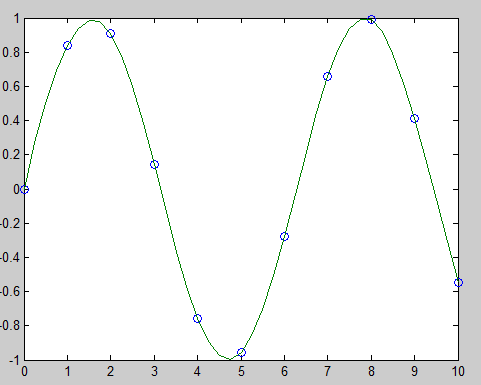
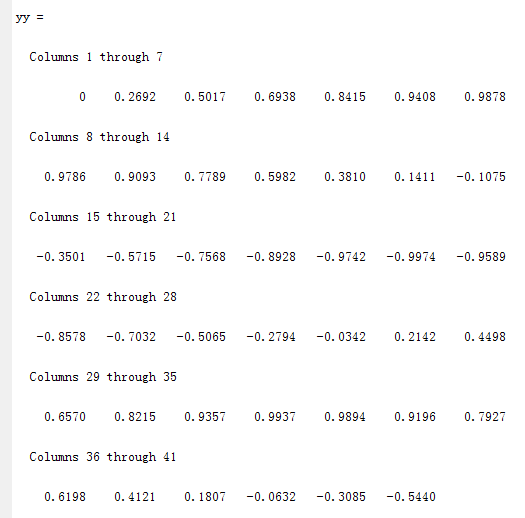
到此为止,都是准备工作做,下面开始介绍如何在vs中调用spline函数。
1)在matlab中输入命令 mbuild -setup , 运行结果如下图所示, 按照提示选择编译器 vs2010.
mbuild -setup
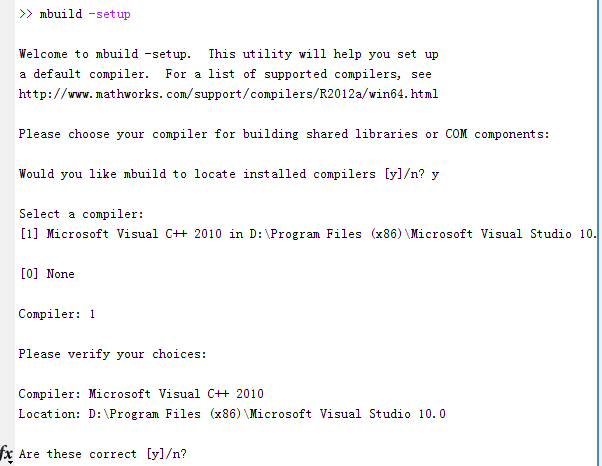
然后键入:mex -setup 命令,运行结果如下图所示,按照提示选择编译器 vs2010
mex -setup

然后在matlab命令窗口输入:
mcc -W cpplib:libspline -T link:lib spline.m
spline是名字,会根据.m文件的不同而不同!!!
或者输入:mcc -B csharedlib:name name.m
可以得到如下图这些文件:
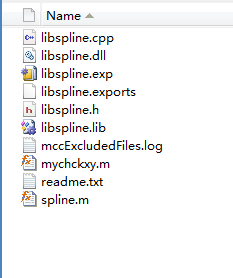
依然,其中的"libspline.dll"、"libspline.h"和"libspline.lib"这三个文件是我们所需的。

2)打开vs2010建一个控制台应用程序,可以选择一个空的控制台应用程序。
创建程序之后把第一步中得到的三个文件copy到工程中。
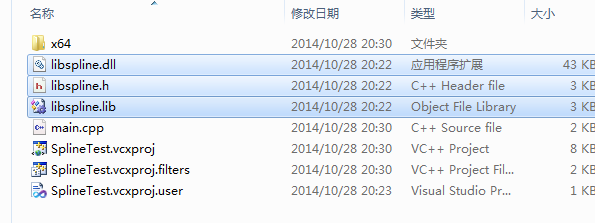
由于我的电脑是win 7 64bit(win8 64bit),matlab是64bit,所以应该选择x64,而不是win32平台。
a)修改平台参数,为x64
生成 ---> 配置管理器


b)配置包含目录与库目录
项目 ----> 属性 ----> vc++目录

包含目录:
D:\Program Files\MATLAB\R2012a\extern\include

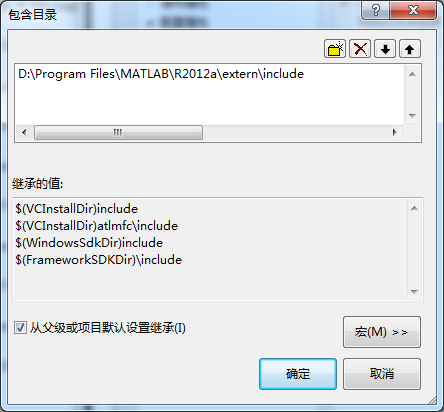
库目录:
D:\Program Files\MATLAB\R2012a\extern\lib\win64\microsoft
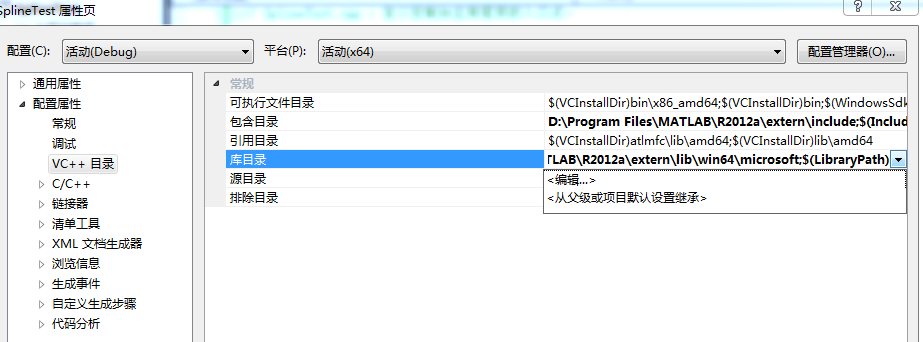

C1)配置附加依赖项
右键MatlabTest解决方案->属性->链接器->输入
在“附加依赖项中”中添加相应的静态链接库文件。对于需要添加的静态库文件的数量和名称,根据需要添加。
libmx.lib
libeng.lib
libmex.lib
libmat.lib
…………
根据需要后续补上。
c2)配置附加依赖项 , 这里根据项目的不同,依赖的文件不同,这里测试依赖的是"mclmcrrt.lib"和"libspline.lib"这两个lib,第一是库lib,第二个是我们生成的lib.文件。所依赖的lib文件在库目录已经说明了,
路径为:D:\Program Files\MATLAB\R2012a\extern\lib\win64\microsoft下。
这里有两种解决方案,第一种在vs中配置。
第一种在vs中配置。建议采用第二种方法!!!!因为第一种不同链接库配置的lib会不一样
项目 ----> 属性 ----> 连接器 ----> 输入

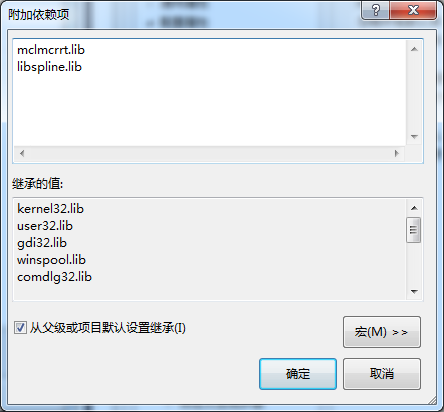
第二种方法是,在文件中直接引入lib文件。

做完以上工作后,我们新建一个主函数作为入口函数,具体测试代码如下:

#include "libspline.h" //增加头文件
#include <cmath>
#include <iostream>
#include <iomanip>
using namespace std; #pragma comment(lib,"mclmcrrt.lib")
#pragma comment(lib,"libspline.lib") int main()
{
//初始化lib(必须)
if (!libsplineInitialize())
return -1; int i, j;
double x[1][11], y[1][11];
for(i=0; i<11; i++)
{
x[0][i] = i;
y[0][i] = sin(x[0][i]);
} double xx[1][41];
for(i=0; i<41; i++)
xx[0][i] = i*0.25; double yy[1][41]; mwArray mwX(1,11,mxDOUBLE_CLASS);
mwArray mwY(1,11,mxDOUBLE_CLASS);
mwArray mwXX(1,41,mxDOUBLE_CLASS);
mwArray mwYY(1,41,mxDOUBLE_CLASS);
mwX.SetData(*x, 11);
mwY.SetData(*y, 11);
mwXX.SetData(*xx, 41);
mwYY.SetData(*yy, 41); spline(1, mwYY, mwX, mwY, mwXX); //调用spline cout<<"yy = "<<endl;
i = 0;
for(j = 0; j < 41; j++)
{
//Get第一个参数表示用1个下标访问元素,j+1是列号(MATLAB下标从1开始,而C++从0开始,故做+1操作)
yy[0][j] = mwYY.Get(1,j+1);
cout<<setprecision(4)<<right<<setw(10)<<yy[0][j];
i++;
if(i%7 == 0) cout<<endl; //换行
}
cout<<endl; //终止调用
libsplineTerminate(); return 0;
}

运行结果如图:
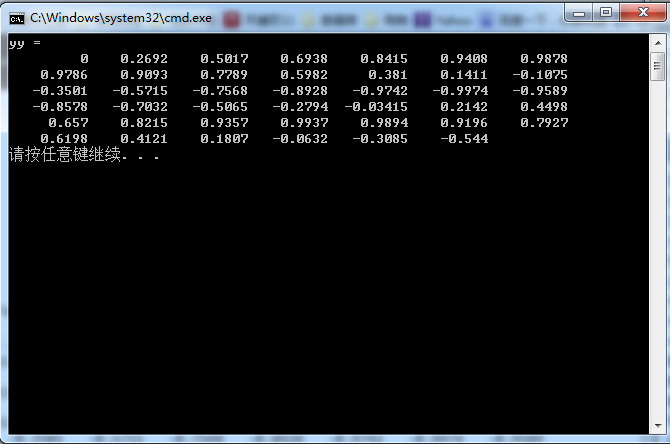
比较这个结果与最开始我们测试matlab运行的结果,测试通过。matlab配置完成。
ps说明:配置过程中遇到的问题:
配置时经常遇到 LINK2019的错误。这种错误就是典型的lib缺失导入的问题。
main.obj : error LNK2019: 无法解析的外部符号 mclGetMatrix_proxy,该符号在函数 "public: __cdecl mwArray::mwArray(unsigned __int64,unsigned __int64,enum mxClassID,enum mxComplexity)" (??0mwArray@@QEAA@_K0W4mxClassID@@W4mxComplexity@@@Z) 中被引用
1>main.obj : error LNK2019: 无法解析的外部符号 mclcppGetLastError_proxy,该符号在函数 "public: static void __cdecl mwException::raise_error(void)" (?raise_error@mwException@@SAXXZ) 中被引用
1>main.obj : error LNK2019: 无法解析的外部符号 mclcppCreateError_proxy,该符号在函数 "public: __cdecl mwException::mwException(void)" (??0mwException@@QEAA@XZ) 中被引用
1>main.obj : error LNK2019: 无法解析的外部符号 ref_count_obj_addref_proxy,该符号在函数 "public: __cdecl mwException::mwException(class mwException const &)" (??0mwException@@QEAA@AEBV0@@Z) 中被引用
1>main.obj : error LNK2019: 无法解析的外部符号 ref_count_obj_release_proxy,该符号在函数 "public: virtual __cdecl mwException::~mwException(void)" (??1mwException@@UEAA@XZ) 中被引用
1>main.obj : error LNK2019: 无法解析的外部符号 error_info_get_message_proxy,该符号在函数 "public: virtual char const * __cdecl mwException::what(void)const " (?what@mwException@@UEBAPEBDXZ) 中被引用
1>main.obj : error LNK2019: 无法解析的外部符号 array_ref_getV_int_proxy,该符号在函数 "public: class mwArray __cdecl mwArray::GetPromoted(unsigned __int64,...)" (?GetPromoted@mwArray@@QEAA?AV1@_KZZ) 中被引用
1>main.obj : error LNK2019: 无法解析的外部符号 array_ref_set_numeric_mxDouble_proxy,该符号在函数 "public: void __cdecl mwArray::SetData(double *,unsigned __int64)" (?SetData@mwArray@@QEAAXPEAN_K@Z) 中被引用
1>main.obj : error LNK2019: 无法解析的外部符号 array_ref_get_numeric_mxDouble_proxy,该符号在函数 "public: __cdecl mwArray::operator double(void)const " (??BmwArray@@QEBANXZ) 中被引用
这里是因为缺少:mclmcrrt.lib
#pragma comment(lib,"mclmcrrt.lib")
即可解决。
matlab 2012 vs2010混合编程的更多相关文章
- 算法库:Matlab与C++混合编程
算法库:Matlab与C++混合编程 最近做光流算法预演过程中,下载的源码中涉及到了Matlab和C++的混合编程.在同事Matlab2014的环境下,程序到是一下就运行通过了.但在我这Matlab2 ...
- Matlab与.NET混合编程解决人脸识别问题
原文:[原创]Matlab与.NET混合编程解决人脸识别问题 如果这些文章对你有用,有帮助,期待更多开源组件介绍,请不要吝啬手中的鼠标. [原创分享]Matlab.NET混编调用Figure窗体 ht ...
- 【目录】Matlab和C#混合编程文章目录
本博客所有文章分类的总目录链接:[总目录]本博客博文总目录-实时更新 1.Matlab和C#混合编程文章目录 9.接触Matlab10年后的一个总结,随时使用Matlab要掌握的一些要点 8.国内第一 ...
- Matlab与C++混合编程(依赖OpenCV)
Matlab与C++混合编程实际上就是通过Matlab的Mex工具将C++的代码编译成Matlab支持调用的可执行文件和函数接口.这样一方面可以在Matlab中利用已经编写好的函数,尽管这个函数是用C ...
- matlab与vs混合编程/matlab移植
前言 项目算法中包含了不同编译工具的代码,分别是matlab和VS,需要将二者结合起来,统一在同一个系统工作,此时就要用到matlab和vs混合编程. 在matlab中将.m文件编译生成库文件等供外部 ...
- matlab和c++混合编程---matlab和vs的环境配置问题及方法和步骤(转载)
matlab和c++混合编程---方法和步骤 matlab和c++混合编程---matlab和vs的环境配置问题 摘要:Matlab具有很强的数值计算和分析等能力,而C/C++是目前最为流行的高级程序 ...
- [转] Matlab与C++混合编程(依赖OpenCV)
作者 zouxy09@qq.com,原文 Matlab与C++混合编程(依赖OpenCV) 之前在运行别人论文的代码的时候,经常有遇到Matlab与C++混合编程的影子.实际上就是通过Matlab的M ...
- [转] Matlab与C++混合编程,添加OpenCV库
原文地址 峰回璐转 最近在做运动医学软件优化工作,此款软件框架及算法语言全由matlab实现,虽然matlab矩阵运算.数值计算能力强大,但速度让人难以忍 受.软件立刻移植到C++上又不太实际,故采用 ...
- Matlab与C++混合编程,添加OpenCV库
最近在做运动医学软件优化工作,此款软件框架及算法语言全由matlab实现,虽然matlab矩阵运算.数值计算能力强大,但速度让人难以忍受.软件立刻移植到C++上又不太实际,故采用联合编程的方式,速度难 ...
随机推荐
- 选择排序算法Java与Python实现
Java 实现 package common; public class SimpleArithmetic { /** * 选择排序 * 输入整形数组:a[n] [4.5.3.7] * 1. 取数组编 ...
- Css3_必备10个东西
1.边框圆角(Border Radiuas) 这个是我们在平常很常用的吧,以前我在用div圆角的时候,特别特别的痛苦,不管是用CSS来画圆角,还是用图片来画圆角都不那么容易,但是现在好了,在CSS3中 ...
- linux runlevel
Linux系统有7个运行级别(runlevel)运行级别0:系统停机状态,系统默认运行级别不能设为0,否则不能正常启动运行级别1:单用户工作状态,root权限,用于系统维护,禁止远程登陆运行级别2:多 ...
- karma+angular
下面的介绍以karma能正常运行为前提,看karma系列文章:http://www.cnblogs.com/laixiangran/tag/Karma/ 目录结构 步骤 安装 npm install ...
- ctrl + d 在phpstorm 和 eclipse 中的不同含义
Ctrl + d 在phpstrom是复制一行,非常的方便,但是eclipse中却是删除一行,非常的特别.感觉上,phpstorm更注重鼠标,但eclipse貌似更多鼠标和键盘的操作, 默认情况下[p ...
- entity reference在views中的运用
一个views block可以获取从url过来的nid,某个node的有entity reference字段, 填入一点数据,然后在views里关联一下这个entity reference field ...
- A7600官方ROM_VIBEUI_V2.5_1537联通版使用体验
A7600官方ROM_VIBEUI_V2.5_1537联通版使用体验 A7600我原来的ROM是西关少爷精简的VIBEUI1521,已经root,后来不小心恢复了出厂设置,然后就出现异常了,用twrp ...
- robotframework笔记1
机器人框架是一个基于Python的,可扩展的关键字驱动的自动化测试最终到终端的验收测试和验收测试驱动开发(ATDD)框架.它可用于检测分布式异类应用程序,其中,验证要求感人几种技术和接口. 下面列出了 ...
- [redis] Jedis 与 ShardedJedis 设计
Jedis设计 Jedis作为推荐的java语言redis客户端,其抽象封装为三部分: 对象池设计:Pool,JedisPool,GenericObjectPool,BasePoolableObjec ...
- 《Java程序设计》实验二 实验报告
实验二 Java面向对象程序设计 实验内容 初步掌握单元测试和TDD 理解并掌握面向对象三要素:封装.继承.多态 初步掌握UML建模 熟悉S.O.L.I.D原则 了解设计模式 实验要求 1.没有Lin ...
